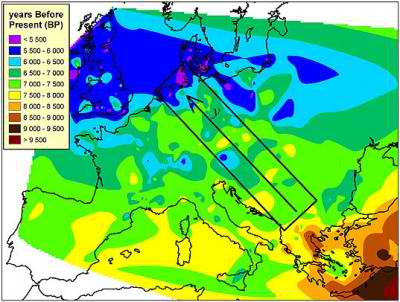One of the most significant socioeconomic changes in the history of humanity started taking place around 10,000 years ago, when the Near East went from an economy based on hunting and gathering (Mesolithic) to another kind on agriculture (Neolithic) and farming rapidly entered the Balkan Peninsula and then advanced gradually throughout the rest of Europe.
But why did this process slow so dramatically as it moved towards the north of the continent? Writing in, of all places, the New Journal of Physics, a group of physicists from the University of Girona (UdG) presented their numerical model which they say explains the anthropological mystery of why the Neolithic front slowed - and hunters were the reason.
"The model shows that the farmers' dispersal and reproduction was limited by the high density of hunter-gatherers in northern Europe," Neus Isern, a physicist at the UdG and lead author of the study, told SINC.

The chronology of the Neolithic wave of advance in Europe, according to a new model. The arrow corresponds to the Y-direction in the model. Credit: J. Fort y N. Isern.
The "reaction-diffusion" model explains the archaeological data and the decline in the speed of progress of the Neolithic front. This is based on two mathematical effects relating to the availability of space for the incomers (dispersal of farmers dependent on spatial variation in the population density of hunter-gatherers, and a modified population growth equation).
"The density of hunter-gatherers was higher in northern latitudes, which enables the model to explain the deceleration in the Neolithic transition in Europe", explains Joaquim Fort, the other author of the study and also a physicist at the UdG.
The authors also stress that the same model "could be applied to many other examples of invasion fronts, in which indigenous populations and invaders compete for a space within a unique biological niche, both in terms of natural habitats and microbiological assays".
Citation : Neus Isern and Joaquim Fort, 'Anisotropic dispersion, space competition and the slowdown of the Neolithic transition', New Journal of Physics 12: 123002, December 2010. Doi: 10.1088/1367-2630/12/12/123002.






Comments